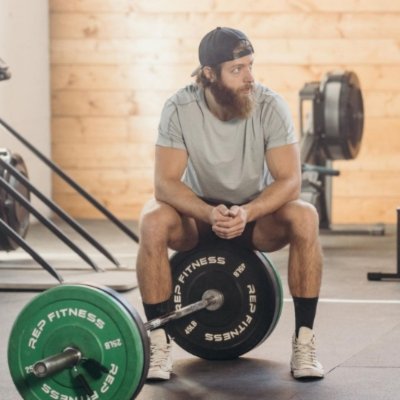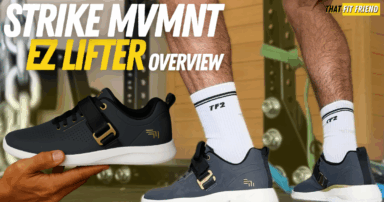A strong deadlift starts with the feet and a strong deadlift stance. When we think about deadlifts, very rarely do we give a lot of thought to our feet and how they’re positioned.
The norm is to think about bigger things like our hip hinge and locking out deadlifts, and these are crucial no doubt, but I’d argue that your stance should take precedence over these.
To find your optimal deadlift stance, assess your foot position with your hip width. Generally speaking, if you can set up to where the knees are stacking over the feet, then you’ll be better poised to leverage your quads and get more out of your deadlift.
Deadlift Stance Key Takeaways
- Deadlift stance is individual and you’ll have to play with your form and setup to see what works best for you. There is no “perfect” or “one-size-fits-all” deadlift stance.
- Typically, if you set your stance based on your hip width you’ll be better off than the traditional, “your stance should be the same width as the shoulders”. The latter is misleading and not ideal for multiple types of anatomies.
- For a quick self-assessment, video your deadlift then scrub your pull in slow-motion and assess what’s happening with your knees and feet. Are the knees stacking over the feet and are you levering the quads or are you pulling on a shaky and wobbling base?
How to Find Your Ideal Deadlift Stance
There are a few ways that I like to help lifters find their deadlift stance. Over the course of your lifting career, it’s normal to play with different stance widths as you learn more about yourself, get stronger, and improve your deadlift.
On top of this, it’s important to remember that even a small change in your deadlift stance can change a lot with your deadlift mechanics, so it’s always wise to give yourself a few weeks to adjust, and I’ll expand more on this below.
Step 1: Set Up a Camera to Video Your Deadlift
I know, I know. Videoing yourself in the gym can be tough, but one of the easiest and simplest ways to get immediate lifting feedback is to video yourself and then replay the video to learn more about your form.
Ideally, you’ll want to film yourself from two angles. First, you’ll want to set up your phone in front of you for a set or two. Second, film yourself from a front diagonal angle, think 45 degrees of an offset from where you’re standing and facing.
Step 2: Start Around Hip Width
When changing your deadlift stance, I’d suggest using easier to moderate loads. You do NOT want to change something like your deadlift stance on a day where you’re working heavy singles, doubles, and triples. Remember, a stance change will and can change mechanics drastically.
Good Set Examples With Loads to Try a Stance Change Width:
- 3×3 @ 75% of your 1-RM
- 3×5 @ 70% of your 1-RM
- 4×2 @ 80% of your 1-RM
Start by setting your deadlift stance around hip width for some moderate-intensity sets. When you look down at the barbell your knees should be in-line with your toes. Then, as you set, when you look down your knees should be covering the toes or covering the lateral part of the foot and toes.
The reason there can be variance here is that different hip and femur anatomies will present differently regarding what you see when looking at your stance from a top-down point of view.
For example, if you have long femurs and hips sockets that are deeper, then you might find that your knees don’t cover the toes fully and bias the lateral part of the foot a bit more, that’s normal.
Step 3: Assess, Track, and Analyze
Once you’ve established the initial deadlift stance that you’re assessing you’ll try it out for 2-3 weeks. I always suggest giving it a few weeks or trying the stance for a full training block to give yourself time to adjust and assess if it works.
When lifting and videoing your sets, you want to look at what the knees are doing throughout your set. Ideally, they shouldn’t be moving a ton from side to side as you pull and if you do notice a lot of movement, then that would be a sign to adjust your deadlift stance.
If you notice at lockout or during your pull that your knees are well inside the feet, then you may want to consider narrowing your width. Check out my example below covering two different stance widths at lockout.
- Lifter 1: Wider Stance
- Lifter 2: Stacked Stance

While obviously, my 2-D drawing doesn’t do the complexity of our bodies and movement justice, the takeaway I want to drive home is that your knees should ideally be over the feet so you can better leverage your quads to create strong knee extension.
Coaching Note: As the weight on the bar gets heavier, it’s normal to see the knees “shake” or move a bit regarding side-to-side movement. However, there’s a threshold as to what’s “too much” and that’s the point I want to drive home.
Don’t be afraid of some movement or put yourself into a box of rigid thinking with your stance and knee movement. At the end of the day, we’re not robots and it’s normal to see joints move in a variety of ways, and understanding movement thresholds that limit performance is the big key.
I liken it to squats and how knee movement can vary throughout different intensities. For example, as we squat heavier, it’s normal to see more internal rotation at the knee as that’s our body self-organizing for the task at hand. Similarly, the body will adjust to the tasks we throw at it with deadlifts.
What Deadlift Stance Is Best?
The best deadlift stance will be individual to your body and set you up for success regarding using your limbs and anatomy to move the most weight possible. Ideally, you want a stance that sets you up to better use your quads when breaking the floor and extending the knees.
The common logic of adjusting your stance based on shoulder width is a little dated, in my opinion, and that doesn’t equate to efficient mechanics for a variety of anatomies.
For example, if you’re a taller lifter with long legs, a narrow hip width, and broad shoulders, then basing your stance on your shoulder width will likely not be ideal for your deadlift mechanics and be a sub-par choice.
Another example of why basing your deadlift stance on shoulder width is short-sighted is for the lifter with wider hips and narrow shoulder width. For this lifter, their hands and arms likely feel like they “get in the way” when deadlifting.
Instead, basing your deadlift stance, or at least starting your deadlift stance exploration, based on your hip width can be far more productive and give you a better starting point behind what will work best for you.
Wide Versus Narrow Deadlift Stance
For conventional deadlifts, a narrower stance that positions the feet more over the toes will typically be best for recreational lifters wanting to improve their deadlift.
This means that with regular gym goers’ deadlift stances, they’re adapting a deadlift stance that better stacks the lower body joints over one another. This can be ideal for getting more out of the quads when initiating deadlifts and “pushing” the floor away.
A wider deadlift stance can be great for athletes that have wider builds and great examples of lifters and athletes that adapt wider stances with a ton of benefit are strongman athletes and heavier set lifters.
For lifters with wider hips, you’ll want to typically adopt a wider deadlift stance as this will give you more opportunity to optimize your anatomy and deadlift mechanics. Note, we’re talking about a wider stance with conventional deadlifts, I’m not referencing sumo deadlifts.
Should My Toes Be Facing Forward With My Deadlift Stance?
The toes should ideally be facing forward or turned slightly out when setting up and establishing your deadlift stance. Your foot position will vary based on your anatomy and what feels most comfortable for you.
There’s no one-size-fits-all position when it comes to how the toes should be facing in your deadlift. I think there are ranges that will be sub-optimal, but your foot position should be individual and based on what makes you feel most comfortable.
The reason why I recommend having the toes face forward or turned out slightly is that this will be a foot position that will typically give you better balance when deadlifting and better poise the quads to do work.
If your feet are turned out a ton then may lose out on your knee extension potential and if you notice your feet are turned in as you deadlift, then you may see the knees waiver more and collapse inward which can also be sub-optimal.
Frequently Asked Questions (FAQ)
Q:What deadlift stance is best?
Q:What are common deadlift stance mistakes?
Takeaway Thoughts
I think deadlift stance is a topic that constantly gets overlooked by lifters from all walks of life. Strong deadlifts start from the ground and if you can optimize your stance, then you can better leverage your body for bigger pulls.
When establishing your deadlift stance, I’d suggest starting from a point of adjusting your stance width based on your hip width, then testing this for multiple weeks.
After you’ve tested this stance change, you’ll then keep it or micro-adjust your stance again based on the feedback you received using it for a few weeks. Give your body time to adjust and to re-acclimate to the skill of deadlifting as you’re changing a big variable.
If you have additional questions about deadlift stances and what’s best for you, drop a comment below or reach out to me personally via Instagram for some help with your form (@jake_boly or @that_fit_friend)!














Add a Comment